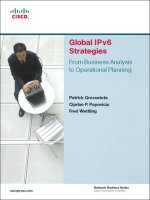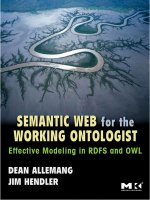IBM press eating the IT elephant moving from greenfield development to brownfield may 2008 ISBN 0137130120
Bạn đang xem bản rút gọn của tài liệu. Xem và tải ngay bản đầy đủ của tài liệu tại đây (3.68 MB, 418 trang )
EatingtheITElephant:MovingfromGreenfield
DevelopmenttoBrownfield
byRichardHopkins;KevinJenkins
Publisher:IBMPress
PubDate:May06,2008
PrintISBN-10:0-13-713012-0
PrintISBN-13:978-0-13-713012-2
eTextISBN-10:0-13-714946-8
eTextISBN-13:978-0-13-714946-9
Pages:256
TableofContents|Index
Overview
APractical,Start-to-FinishApproachtoManaging,
Evolving,andTransformingLegacyITSystems
ForeveryITexecutive,manager,architect,programleader,
projectleader,andleadanalyst
"RichardandKevinintroduceustoarealitythat'soften
neglectedinourindustry:theproblemofevolvinglegacy
systems,adomaintheycall'Brownfielddevelopment.'The
authorsidentifytherootoftheproblemasthatofcomplexity,
andofferanapproachthatfocusesonthefundamentalsof
abstractionandefficientcommunicationtonibbleatthis
problemoftransformationbitbybit.Astheoldsayinggoes,the
wayyoueattheelephantisonebiteatatime.Richardand
Kevinbringustothetablewithknifeandforkandothertools,
andshowusawaytodevourthiselephantintheroom."
GradyBooch,IBMFellow,co-creatorofUML
"Mostorganizationsinthe21stcenturyhaveanexisting,
complexsystemslandscape.ItistimethattheITindustryface
uptotherealityofthesituationandtheneedfornew
developmentmethodsandtoolsthataddressit.Thisbook
describesanewapproachtothedevelopmentoffuture
systems:astructuredapproachthatrecognizesthechallenges
of'Brownfield'development,isbasedonengineeringprinciples,
andissupportedbyappropriatetooling."
ChrisWinter,CEngCITPFBCSFIET,IBMFellow,Memberofthe
IBMAcademyofTechnology
MostconventionalapproachestoITdevelopmentassumethat
you'rebuildingentirelynewsystems.Today,"Greenfield"
developmentisararity.Nearlyeveryprojectexistsinthe
contextofexisting,complexsystemlandscapes--oftenpoorly
documentedandpoorlyunderstood.Now,twoofIBM'smost
experiencedseniorarchitectsofferanewapproachthatisfully
optimizedfortheuniquerealitiesof"Brownfield"development.
RichardHopkinsandKevinJenkinsexplainwhyaccumulated
businessandITcomplexityistherootcauseoflarge-scale
projectfailureandshowhowtoovercomethatcomplexity"one
biteoftheelephantatatime."You'lllearnhowtomanage
everyphaseoftheBrownfieldproject,leveragingbreakthrough
collaboration,communication,andvisualizationtools--including
Web2.0,semanticsoftwareengineering,model-driven
developmentandarchitecture,andevenvirtualworlds.
Thisbookwillhelpyoureengineernewflexibilityandagilityinto
yourITenvironment…integratemoreeffectivelywithpartners…
prepareforemergingbusinesschallenges…improvesystem
reuseandvalue…reduceprojectfailurerates…meetany
businessorITchallengethatrequirestheevolutionor
transformationoflegacysystems.
·Systemcomplexity:understandit,andharnessit
Gobeyondthecomfortingillusionofyourhigh-level
architecturediagrams
·Howconventionaldevelopmenttechniquesactually
makethingsworse
Whytraditionaldecompositionandabstractiondon'twork-andwhattodoinstead
·ReliablyreengineeryourITinlinewithyourbusiness
priorities
Newwaystounderstand,communicate,visualize,
collaborate,andsolvecomplexITproblems
·Cuttheelephantdowntosize,onestepatatime
MasterallfourphasesofaBrownfieldproject:survey,
engineer,accept,anddeploy
EatingtheITElephant:MovingfromGreenfield
DevelopmenttoBrownfield
byRichardHopkins;KevinJenkins
Publisher:IBMPress
PubDate:May06,2008
PrintISBN-10:0-13-713012-0
PrintISBN-13:978-0-13-713012-2
eTextISBN-10:0-13-714946-8
eTextISBN-13:978-0-13-714946-9
Pages:256
TableofContents|Index
Copyright
ForewordbyGradyBooch
ForewordbyChrisWinter
Preface
Acknowledgments
AbouttheAuthors
PartI:IntroducingBrownfield
Chapter1.EatingElephantsIsDifficult
Today'sDeliveryMethods
WhyDoBigProjectsFail?
EnvironmentalComplexity
BrownfieldSitesMustBeSurveyed
Endnotes
Chapter2.TheConfusionofTongues
IntroducingBrownfield
KeyCommunicationProblems
OvercomingCommunicationComplexity
Endnotes
Chapter3.Big-MouthedSuperheroRequired
Elephant-EatingStrategies
ConsumingtheEnvironment
ArchitectingtheElephantEater
TheElephantEaterinAction
TheBrownfieldBeliefs
Endnotes
Chapter4.TheTrunkRoadtotheBrain
AlternativeWallpapers
InvadingHilbertSpace
ArchitectureIstheSolution
BridgingtheBusiness/ITGap
Endnotes
Chapter5.TheMythicalMetaman
WhenYouEliminatetheImpossible
TheLongTailofBusinessServices
BusinessAttractorsforAttractiveBusinesses
TheDeathofBrownfield
Endnotes
PartII:TheElephantEater
Chapter6.AbstractionWorksOnlyinaPerfectWorld
ConsiderationsforanElephantEater
SystemsIntegrationandEngineeringTechniques
AbstractionIstheHeartofArchitecture
DoWeNeedaGrandUnifiedTool?
TheConnoisseur'sGuidetoEatingElephants
Endnotes
Chapter7.EvolutionoftheElephantEater
TheSourcesofBrownfield
Isn'tThisCASE?
Isn'tThisMDA?
Endnotes
Chapter8.BrownfieldDevelopment
AgileWaterfalls
TheBrownfieldDevelopmentApproach
Endnotes
Chapter9.InsidetheElephantEater
LookingInsidetheElephantEater
Step1:ParseViewandIdentifyPatterns
Step2:MergeViews
Step3:CreateTransforms
Step4:GenerateArtifacts
Steps5.1:TestArtifactsand5.1a:IdentifyGeneration
Faults
Step5.1b:AddandUpdateInformation
APortraitofanElephantEater
Endnotes
Chapter10.ElephantEateratWork
MakingtheMovetoBrownfield
TakingtheFirstStep
ABetterWaytoBuildInterfaces
ABetterWaytoBuildanEnterpriseServiceBus
TheEndofMiddleware?
EvolvingaDeployableEnterpriseArchitecture
Index
Copyright
Theauthorsandpublisherhavetakencareinthepreparationof
thisbook,butmakenoexpressedorimpliedwarrantyofany
kindandassumenoresponsibilityforerrorsoromissions.No
liabilityisassumedforincidentalorconsequentialdamagesin
connectionwithorarisingoutoftheuseoftheinformationor
programscontainedherein.
©Copyright2008byInternationalBusinessMachines
Corporation.Allrightsreserved.
NotetoU.S.GovernmentUsers:Documentationrelatedto
restrictedright.Use,duplication,ordisclosureissubjectto
restrictionssetforthinGSAADPScheduleContractwithIBM
Corporation.
IBMPressProgramManagers:TaraWoodman,ElliceUffer
Coverdesign:IBMCorporation
AssociatePublisher:GregWiegand
MarketingManager:KourtnayeSturgeon
Publicist:HeatherFox
AcquisitionsEditor:KatherineBull
DevelopmentEditors:KevinFerguson,GinnyBess
ManagingEditor:GinaKanouse
Designer:AlanClements
SeniorProjectEditor:LoriLyons
CopyEditor:KristaHansing
Indexer:LisaStumpf
Compositor:NonieRatcliff
Proofreader:AnneGoebel
ManufacturingBuyer:DanUhrig
PublishedbyPearsonplc
PublishingasIBMPress
IBMPressoffersexcellentdiscountsonthisbookwhenordered
inquantityforbulkpurchasesorspecialsales,whichmay
includeelectronicversionsand/orcustomcoversandcontent
particulartoyourbusiness,traininggoals,marketingfocus,and
brandinginterests.Formoreinformation,pleasecontact:
U.S.CorporateandGovernmentSales
1-800-382-3419
ForsalesoutsidetheU.S.,pleasecontact:
InternationalSales
Thefollowingtermsaretrademarksorregisteredtrademarksof
InternationalBusinessMachinesCorporationintheUnited
States,othercountries,orboth:IBM,theIBMlogo,IBMPress,
AD/Cycle,DB2,developerWorks,Rational,System360,Tivoli
andWebSphere.JavaandallJava-basedtrademarksare
trademarksofSunMicrosystems,Inc.intheUnitedStates,
othercountries,orboth.Microsoft,Windows,WindowsNT,and
theWindowslogoaretrademarksofMicrosoftCorporationin
theUnitedStates,othercountries,orboth.Othercompany,
product,orservicenamesmaybetrademarksorservicemarks
ofothers.
LibraryofCongressCataloging-in-PublicationData
Hopkins,Richard.
EatingtheITelephant:movingfromgreenfielddevelopmenttobrownfiel
HopkinsandKevinJenkins.
p.cm.
Includesindex.
ISBN0-13-7130120(pbk.:alk.paper)1.Informationtechnology.2.Business
enterprises—Planning.I.Jenkins,Kevin.II.Title.
T58.5.H692008
004.068—dc22
2008004231
Allrightsreserved.Thispublicationisprotectedbycopyright,
andpermissionmustbeobtainedfromthepublisherpriorto
anyprohibitedreproduction,storageinaretrievalsystem,or
transmissioninanyformorbyanymeans,electronic,
mechanical,photocopying,recording,orlikewise.For
informationregardingpermissions,writeto:
PearsonEducation,Inc
RightsandContractsDepartment
501BoylstonStreet,Suite900
Boston,MA02116
Fax(617)6713447
ISBN-13:978-013713012
TextprintedintheUnitedStatesonrecycledpaperatR.R.
DonnelleyinCrawfordsville,Indiana.
FirstprintingMay2008
Dedication
ToMam,Dad,Lyndsay,andthethreebestkidsinthe
world:Kirsty,Julia,andNicholas.Theywouldhave
preferredabookonrealelephants,butatleastthey
approveofthecover.
—R.H.
ToAnna,forsupportingmethroughthestressfultimesof
deliveringlargeprojects.
—K.J.
ForewordbyGradyBooch
Asimpleback-of-the-envelopecalculationsuggeststhat,
worldwide,weproduceabout33billionlinesofnewormodified
codeeveryyear.Cumulatively,thismeansthatsincethe1940s
and'50s(whenhigherorderprogramminglanguagesbeganto
gainsometraction),we'veproducedsomewherearoundone
trillionsourcelinesofcode.
Ontheonehand,thisvolumeofoutputsuggeststhatoursisan
incrediblyvibrantandinnovativeindustry.Ontheotherhand,
it'sahumblingthought,forthroughthosetrillionlinesofcode,
allhandcraftedbyindividualhumanlabor,we'vechangedthe
world.
Truthbetold,somenontrivialpercentageofthe33billionlines
yearlyisdeadonarrivalorsotransitorythatit'sthrownaway
quickly.Muchofthatcode,however,hasalongerhalf-life,and
evensomeofthatcodelivesafter10,20,oreven30ormore
years.Formanydevelopers,thecodetheywritetodaybecomes
tomorrow'slegacythattheirchildrenortheirchildren'schildren
maystareatsomeday,tryingtouseit,adaptit,evolveit,
askingthequestion,"Whattheheckwasthisdeveloper
thinking?"
Greenfielddevelopment,quitehonestly,isgreatfun,simply
becauseyougettostartwithacleanslateand,thus,arenot
burdenedbyanythingfromthepast.Forthemostpart,we
teachGreenfielddevelopmentinourschools;furthermore,
start-upcompanieslooksomuchmorenimblethantheirolder
counterpartsbecausetheydon'thavethemillstoneoflegacy
aroundtheirnecks.Woebeuntothestudentwhoentersthe
realworld(it'snotlikebeingattheuniversity,unlessyoumove
fromthecollegewombtothestart-upwombimmediately),and
woebeuntothestart-upcompanythatbeginstomatureinto
sustainabledevelopmentandsoonrealizesthatyoucan'tjust
startover.
RichardandKevinintroduceustoarealitythat'soften
neglectedinourindustry:theproblemofevolvinglegacy
systems,adomaintheycallBrownfielddevelopment.The
typicaleconomicallyinterestingsystemthesedaysis
continuouslyevolving(youcan'tshutitoff)andever-growing.
Theauthorsidentifytherootoftheproblemasthatof
complexity,andofferanapproachthatfocusesonthe
fundamentalsofabstractionandefficientcommunicationto
nibbleatthisproblemoftransformationbitbybit.Theirmodel
ofViews,Inventory,Transforms,andArtifactsoffersan
approachtoreasoningaboutandexecutingonthe
transformationofBrownfieldsystems.Theyproposea
Brownfieldlifecycleinvolvingsurveying,engineering,
acceptance,anddeploymentthatoffersameansofgoverning
thistransformation.
Astheoldsayinggoes,thewayyoueattheelephantisonebite
atatime.RichardandKevinbringustothetablewithknifeand
forkandothertools,andshowusawaytodevourthiselephant
intheroom.
GradyBooch
IBMFellow
January2008
ForewordbyChrisWinter
Ijoinedthecomputerindustryasacomputerprogrammer,
straightfromschool,in1969.Duringacareerthathasspanned
nearly40years,Ihaveworkedprimarilyintheareaof
applicationsdevelopmentandsystemsintegration.Iwrotemy
firstapplicationin1969;itwasaComputerAidedDesign(CAD)
graphicsapplicationforhardwareengineerstodesignPrinted
CircuitBoards.Thisapplicationgavetheboarddesigneratool
withthenecessaryphysicalrulesoftheelectroniccomponents
andhowtheycouldbeused.Intheearly1970s,Ideveloped
CADandotherapplicationstoassistbuildingarchitectsin
designinglargepublicbuildings,suchasschoolsandhospitals.
Thesesystemsassistedthearchitectsandcivilengineersinthe
designprocessofthebuilding;bycapturingthedesign,itwas
possibletoproduceallthenecessarydrawingstogetherwith
thebillsofmaterialsforthebuilding.
Intheintervening40years,Ihaveperformedavarietyof
differentroles,includingprogrammer,analyst,designer,
architect,projectmanager,andtroubleshooter.ThesystemsI
developedwereinabroadspectrumofindustries,including
manufacturing,banking,insurance,retail,utilities,andboth
localandfederalgovernment.Today,IamanIBMFellow[1]in
theIBMGlobalBusinessServicesdivisionandanactive
memberoftheIBMAcademyofTechnology.[2]Myprimary
responsibilityistotechnicallyshapeandensurethetechnical
healthoflargeandcomplexsystemsintegrationandstrategic
outsourcingprogramsandbids.IamaCharteredIT
Professional(CITP),aCharteredEngineer(CEng),aFellowof
theBritishComputerSociety(FBCS),[3]andaFellowofthe
InstitutionofEngineeringandTechnology(FIET).[4]
Lookingbacknowonwhatwetriedtoachievewiththedesign
andbuildofelectroniccircuitsandbuildingsintheearly1970s,
IamdisappointedandsomewhatdisillusionedbytheIT
industry'slackofsuccessinitsownadoptionofengineering-
basedmethodssupportedbycomputer-basedtoolstoarchitect,
design,build,integrate,andtestITsystems.Intoday'sworld,
itwouldbeinconceivabletodevelopacomplexsystemsuchas
theAirbus380withouttheengineeringdisciplinesandwithout
theengineeringtoolsprovidedbytheITindustry.TheIT
industryissignificantlylessmatureatadoptingengineering
techniquestodevelopitscomplexsystems.Itcannolonger
relyonrelativelyimmaturepracticesoftensupportedbyoffice
productivitytoolssuchaswordprocessors,presentationtools,
andspreadsheets.TheITindustryneedsabroaderadoptionof
trueengineering-basedtechniquessupportedbytoolsdesigned
forengineers.
Ithasbeenmypersonalexperienceinrecentyearsthatthe
overallcostandcomplexityofbuildingbespoke(custom)
applicationsorcustomizingCommercialOffTheShelf(COTS)
packageshasincreased—ashastherisk.Onfurther
investigation,itisapparentthatitisnotthebuildcostthathas
increased,buttheincreaseinthesizeandcomplexityofthe
integrationofsuchprojectsintothesystemslandscape.From
myownrecentexperience,theratioofeffortofnewbuildto
integrationis3:1.Foreverydollarspentonnewfunctionality,
thetotalcostisfourdollarstocutoverthisfunctioninto
production.Thiscostexcludesend-usertraining.Inan
environmentwherebothsizeandcomplexityofthesystems
landscapearecontinuallyincreasing,thereisaresulting
increaseinthecostsofmaintenance.Inaddition,organizations
areburdenedwithaneedtomeetincreasinglevelsof
legislationandregulation.Allofthisresultsinreducedbudgets
fornewdevelopmenttogetherwithdecreasingwindowsof
opportunitytodeploynewfunctionintheglobal24x7service
culture.ITinnovationisbeingstifled.Themethodsandtools
thatareinusetoday,albeitlimited,areinthemain,primarily
targetedatGreenfieldsystem'slandscapes.Therealityisthat
mostorganizationsinthetwenty-firstcenturyhaveanexisting,
complexsystemslandscape.WhenIrefertothesystems
landscape,ImeanboththebusinessanditsenablingIT
systems.TheseITsystems,inturn,arecomprisedof
applicationsandtheirdatadeployedonoftencomplexnetwork
andcomputerinfrastructure.Thedocumentationofsuch
systemsistypicallypooranditsongoingmaintenanceishighly
dependentonasmallnumberofknowledgeable"system
experts."[5]TheITindustryneedsamorestructuredapproach
tounderstandingthesesystemlandscapes.
Thisistherealityoftheworldinwhichtheauthorsofthisbook,
RichardHopkinsandKevinJenkins,andI,architect,design,and
implementnewsystemsforourclientsinexistingcomplex
systemslandscapes.ItistimethattheITindustryfaceupto
therealityofthesituationandtheneedfornewdevelopment
methodsandtoolsthataddresstheseissuesandtakeour
industryintothetwenty-firstcentury.
Animportantfirststepinresolvingthisistoprovideaname
thatdescribesboththeproblemanditssolution.Inthesearch
foraname,theauthorshaveturnedtothebuildingindustry
wherenewbuildingsareincreasinglybeingdevelopedon
Brownfield[6]sites.Thisisanalogoustothemajorityoftoday's
newsystemsthatarebeingdevelopedonBrownfieldsystems
landscapes;itismyexperiencethatmorethan90percentof
newdevelopmentisdeployedintoaBrownfieldenvironment.
Thechallengesarenotrestrictedtojustthetransformationof
legacysystems,butwiththeintegrationintotheBrownfield
systemslandscapeitself.
Thisbookdescribesanewapproachtothedevelopmentof
futuresystems.Itisastructuredapproachthatrecognizes
thesechallenges,itisbasedonengineeringprinciples,anditis
supportedbyappropriatetooling.Itisspecificallydesignedto
solvethechallengesofBrownfielddevelopment.
ChrisWinter
CEngCITPFBCSFIET,IBMFellow
MemberoftheIBMAcademyofTechnology
ForewordEndnotes
1. "IBMAppointsSixNewFellowsWhoExplorethe
BoundariesofTechnology." />May2007.
2. IBMAcademy. />3. BritishComputerSociety. />4. TheInstitutionofEngineeringandTechnology.
/>5. Lindeque,P."WhydolargeITprogrammesfail?"
/>Index=390,September2006.
6. BrownfieldisdescribedbytheNational
AssociationofRealtors®as"Theredevelopment
ofexistingurban,suburban,andruralproperties
alreadyservedbyinfrastructureincluding
'brownfields'sites,thatareormaybe
contaminated,stimulatesgrowthandimprovesa
community'seconomicvitality.Developmentin
existingneighborhoodsisanapproachtogrowth
thatcanbecost-effectivewhileproviding
residentswithacloserproximitytojobs,public
services,andamenities."
Preface
Withineverybusiness,thereisadesireforrapidchangeto
meetcustomerdemands.Suchchangesusuallyinvolve
changingsupportingITsystems.Whenlargebusinesschanges
arerequired,theaccompanyingITchangestendtobe
significant,too.However,alltoooften,thesebigprojectshit
problems,runoverbudget,aredelayed,orsimplyget
cancelled.Evenin2006,65%ofITprojectsfailedononeof
thesecounts.[1]Largeprojectshaveanevenpoorersuccess
rate.Suchoddsareveryworryingwhenthestakesarevery
high.Thisbookidentifiesthefundamentalissuesattheheartof
theITindustry'scurrentapproachesandprovidesanewway
forward.Allpeopleinvolvedinlarge-scalebusinessandIT
changeshouldreadthisbook.
TheDaytheElephantWasBorn
TheITindustryhasmanykeydates,buttheintroductionin
1964ofIBM'snew-generationmainframe,calledthe
System/360,markedthestartofanewera.Untilthatpoint,
buyinganewbusinesscomputermeantrewritingyourexisting
software.TheSystem/360changedallthatwiththe
introductionofafamilyofcompatiblecomputersandassociated
devices:Aprogramthatranononewouldrunonany.The
industryfollowedsuitwithequivalentproducts,andthenature
ofITchangedinonefellswoop.
ITinvestmentscouldnowbeeasilypreserved.Theprograms
thatranontheSystem/360stillrunonIBM'smainframe
platformstoday.
Thiswasanimperceptiblechangeatfirst,butitwasahugely
significantmilestone.Atthispoint,ITcomplexitystarted
accumulatingwithintheenterprise.Systemsgrewwiththe
business.Thousandsofperson-yearsoftime,effort,andmoney
flowedintotheseITsystems.Theygotcomplex.Theybecame
elephants.
Inthemeantime,ITfashionscameandwent.Overtheyears,
theoriginalstructuredprogramshavebeenaugmentedby
object-orientedprogramming,wrappedbycomponent-based
development,andadvertisedbyServiceOrientedArchitecture
(SOA).Eachofthesemovementshashaditsownstrategyfor
dealingwiththecomplexity,butnoneeverreallytookitto
heart.
Today'sITsystemsaresocomplexthattheysimplydefy
everydaycomprehension,spillingoutofourmindsaswetryto
getourheadsaroundthem.Responsibilityformaintainingthem
issplitamongavarietyofskilledgroupsandmyriadproducts
andprogramsthatcoexisttosupportthefunctionsofthe
enterprise.TodealwiththisHydra,wedrawhigh-level
architecturediagramsthatcomfortusbymakingthingslook
simple.Thesediagramsareanillusion,atrick,afacade.They
are,atbest,approximationsforeasyconsumptionandhighlevelcommunication.Atworst,theyinstillfalseoptimismabout
ourabilitytomakechangestothatcomplexity.
Such"fluffycloud"diagramscannothidegenuinecomplexity
forever.Toachieveyourbusinessgoalsandchangethose
systems,youmustunderstand,communicate,andharnessthe
realcomplexity.Noonecanunderstandthewholebeast,so
vastamountsofwell-coordinatedteamworkandunambiguous
communicationarerequiredtocompletesuchtasks.This
combinationofhighlevelsofcomplexityandtheneedforclear
communicationofthatcomplexityamonghundredsof
individualsdestroysbigprojects.
DoINeedtoMovefromGreenfieldto
Brownfield?
ITsystemsaregenerallynotimplementedonGreenfieldsany
more.Theaccumulatedcomplexitysince1964meansthatthe
environmentformostbigITprojectsisoneofimmense
challenge,entangledinanalmostuncountablenumberof
environmentalconstraints.
Thisistheunderlyingreasonforthedemiseofmostlarge-scale
ITprojects.Only30%oflargeITprojectssucceed.
Bigprojectsareusuallyexecutedon"contaminated"sites,
whereyouneedtobecarefulofwhereandhowyoubuild;a
changeinoneplacecanripplethroughtoothersystemsin
unexpectedways.Suchsitesaremorebrownthangreen,and
theITindustryneedstoadoptaBrownfield-orientedapproach
toaddressthemsuccessfully.
ThisbookintroducessuchaBrownfieldapproachandexplains
whycurrentmethodsarestillessentiallyGreenfield.Itis
specificallywrittenforpeoplewhowanttochangetheir
businessandknowthattheycandoitonlybybuildingonwhat
hasgonebefore.Ifanyofthefollowingistrue,thisbookisfor
you:
YouareaCIO,CTO,ITdirector,projectexecutive,project
director,chiefarchitect,orleadanalystwhois
contemplatingasignificantchangeinyourITlandscape.
YoucannotaffordtoreplaceyourwholeITlandscape.
Yoursystemstalktoafairnumberofsystemsoutsideyour
directcontrol.
YouwouldliketoreengineeryourexistingITenvironment
sothatitwillremainflexibleforthefuture.
Youaredeeplyunhappywiththecurrentfailureratesof
largeITprojects.
YouarecontemplatingsendingasignificantpartofyourIT
developmentandtestingworkoff-shore.
EatingtheITElephantwaswrittenbytwofull-timeExecutiveIT
ArchitectsfromIBMwhocanandhavetickedeverysingleone
ofthoseboxesonanumberofoccasions.Wehavebeen
accountableforthetechnicaldirectionandday-to-day
implementationofsomeofthelargestsystemsintegrationand
reengineeringprojectsthatIBMhasundertaken.Webelieve
stronglythatexistingGreenfielddevelopmentapproachesare
anincreasinglypoormeansofaddressingtoday'sbusiness
problemsthroughITsolutioning.Tobeblunt,wehavea
numberofyearsofhard-wonexperience,andwehavegrown
tiredoftherecurringproblemsofITdelivery.Inrecentyears,
wehavedeliberatelysoughtadifferentapproach;thefollowing
pagesdetailthefruitsofourlaborsandthatofourcolleagues.
Hereticswemightbe,butpragmatistswearealso,and,hand
onheart,wecansaythattheinsightweshareherehas
significantlyacceleratedandsimplifiedanumberofrecentIBM
engagements.
Wedon'tthinkthehighfailurerateofmajorITprojectsisdoing
ourindustryanyfavorsandwouldliketopopularizethe
approachthathasserveduswell.Ifwecanhelpmitigatethe
impactoftheunavoidablycomplexITenvironmentandknock
downsomebigprojectcommunicationbarriers,webelievethat
successratewillimprove.
AReader'sDigest
Thisbookisnotatechnicalmanualnoracookbook;itdoesnot
containasinglelineofcode,andwehavetriedtominimizethe
useoftechnicaldiagramsandjargon.Thisisabookabout
changingthewayweapproachlargeandcomplexbusinessand
ITreengineeringprojects.
Tomakethebookasaccessibletoasmanypeopleaspossible,
wehavesplititintotwoparts.
PartIisforallreaders.Initially,itdefineswhatiswrongwith
large-scaleITprojectsanddeterminestherootcauseoffailure
(seeChapters1,"EatingElephantsIsDifficult,"and2,"The
ConfusionofTongues").Theheartofthebook(Chapters3,
"Big-MouthedSuperheroRequired,"and4,"TheTrunkRoadto
theBrain")concentrateondefininganalternativesolution—an
ElephantEater—andtheBrownfieldapproachthatgoeswithit.
InChapter5,"TheMythicalMetaman,"welookatthenew
speciesofbusinessesthatemergeasaresult.
PartIIexplainsthetechnicalandpracticalaspectsofBrownfield
forsomeonewhomightwanttoimplementsuchanapproach.It
startsbyanalyzingexistingElephantEatingtechniques(see
Chapter6,"AbstractionWorksOnlyinaPerfectWorld")and
explainswhyBrownfieldisdifferent(seeChapter7,"Evolution
oftheElephantEater").InChapters8,"Brownfield
Development,"and9,"InsidetheElephantEater,"welook
insidetheElephantEaterandatsomeofthenewtechnologies
thathavebeenusedtoimplementit.Thebookconcludesby
explaininghowtheBrownfieldapproachcanbeimplementedon
aprojectandthebenefitsitcanbring(seeChapter10,
"ElephantEateratWork").
Forthosewhotakethekeymessagesonboard,awealthof
technicalinformationhasalreadybeenpublishedthatwill
enableanyorganizationtoadoptthecoretechnologiesthatwe
haveused(orequivalentones)toimplementBrownfieldintheir
ownway(seethe"Endnotes"sectionsofChapters8and9).We
hopethatenablingbusinessandITchangeviaanewproject
approach,nottechnology,isattheheartofthisbook.
PartI:IntroducingBrownfield
Chapter1,"EatingElephantsIsDifficult,"introducesthe
metaphorthatperformingalargeITprojectcanbecompared
toeatinganelephant.Itlooksatwhybigprojectsfailand
providesbestpracticesonhowtoovercomesomeofthe
commonreasonsforfailure.
Chapter2,"TheConfusionofTongues,"explainswhythis
accumulatedITcomplexityistherootcauseoffailure,focusing
onthehumancommunicationproblemsitcreates.Itgoesonto
specificallyexaminethe"greatdivide"betweenbusinessandIT
thatcompoundstheproblem.
Chapter3,"Big-MouthedSuperheroRequired,"introducesthe
coreconceptsofBrownfield.ItlooksathowBrownfieldcanbe
implementedtocreateanefficientElephantEater.
Chapter4,"TheTrunkRoadtotheBrain":WedespairatIT
professionals'inabilitytocommunicateaseffectivelyand
efficientlyasthoseinothersimilarprofessions(suchasreal
architects).Chapter4describeshowtheBrownfieldapproach
combinedwiththeVITAarchitectureopensupnewformsof
communication,remotecollaboration,andvisualizationof
complexITproblems.
Chapter5,"TheMythicalMetaman":Thefirstpartofthebook
concludeswithanexaminationofthelikelyimpactof
Brownfield.Itforecastsanewbreedofbusinessesthatare
infinitelymorecustomerfocusedandagilethantoday'sand
explainshowsuchbusinessesmightcomeintobeing.
PartII:TheElephantEater
Chapter6,"AbstractionWorksOnlyinaPerfectWorld":This
moretechnicalhalfofthebookopensbydefiningthe
characteristicsofanElephantEater.Itconsidersexisting
"ElephantEating"approachesandnotesthattheytendto
compoundprojectdifficultiesviatheirextensiveuseof
decompositionandabstraction.
Chapter7,"EvolutionoftheElephantEater,"looksat
Brownfield'stechnicalandprojectroots,andexplainsitskey
differencesfrompreviousideas.Itendswithsomelikely
scenariosandreal-lifeprojectexamplesforwhichBrownfield
hasbeenorcouldbeespeciallybeneficial.
Chapter8,"BrownfieldDevelopment,"introduceshowthe
Brownfielddevelopmentapproachcanbedeployedonaproject.
ItshowshowtostrikeanewbalancebetweenAgile-and
Waterfall-baseddevelopmenttechniquesandprovidessomeof
thebestelementsofeach.Italsodescribesthecorephasesof
Survey,Engineer,Accept,andDeploy,andstatesthebenefitsof
theapproach.
Chapter9,"InsidetheElephantEater":IfChapter8described
whathappensonaBrownfieldproject,Chapter9explainshow
ithappens.Thischapterlooksinsidetheworkingsofan
ElephantEaterandexplainshowiteatstheelephant.The
chapteralsoservesasaneasy-to-readintroductiontothenew
semantictechnologiesthatunderpinWeb2.0andthesemantic
web.
Chapter10,"ElephantEateratWork":Thebookconcludeswith
alookatthepracticalapplicationsoftheElephantEaterand
howitcanhelpsolvesomeoftoday'smostdifficultIT
problems.Thischapterincludesasummaryofthekeybenefits
oftheBrownfieldapproach.
WalkingtheBrownfields
Wehopethatyouwillenjoyreadingthisbookasmuchaswe
enjoyedwritingit.Ifyou'dliketoseemore,gotothewebsite
www.elephanteaters.org.Additionally,ifyouwouldliketosee
moreofthedynamicnatureofBrownfield,therearetwo
exhibitionsinSecondLife.OneSecondLifesiteisdedicatedto
thebook[Cypa30,180,302].TheotherSecondLifesiteis
dedicatedtotheuseofBrownfieldwithinIBMat[IBM1140,
150,60].Welookforwardtomeetingyouthere.
Endnotes
1. TheinitialCHAOSreportfromStandishGroupin1994reporteda16%
projects.Thissuccessratehasgenerallyincreasedovertheintervening
Groupreported35%ofITprojectsbeingontimeandwithinbudget,an
requirements.Theonlyblipinthatrecordappearedin2004,whenfailu
StandishGroupexplainedthatin2004thereweremorebigprojects—t
becausetheyareoftenforcedtoabandoniterativedevelopmenttechni
In2007,arivalreporttoCHAOSbySauer,Gemino,andHornerReichl
foundthatmorethan65%ofITprojectssucceeded,butitfoundnosu
than200person-years.Thisbooklooksspecificallyatthoselargeproje
Hayes,F.ChaosIsBack.
www.computerworld.com/managementtopics/management/project/sto
Krigsman,M.RearrangingtheDeckChairs:ITProjectFailures
/>
Rubinstein,D.StandishGroupReport.www.sdtimes.com/article/story-2
Sauer,C.,A.Gemino,andB.HornerReigh."TheImpactandSizeandV
Performance."CommunicationsoftheACM50no.11(November2007)
Acknowledgments
Thisbookwouldnothavebeenpossiblewithoutthesupport
andunderstandingofourfamilies(whodon'tseeusenoughat
thebestoftimes).Inaddition,wewouldliketoacknowledge,in
alphabeticalorder,thecontributionofthefollowingpeopleor
companies:
BobLojek—FortakingModelDrivenArchitecturetothe
nextlevelandforinventingthefirstplausibleattemptata
softwareBabelFish.
ChrisWinter—AtrulyinspiringIBMFellowwhobelieves
moreincommunityandthecapabilityofpeoplethan
anyoneelsewe'vemetintheindustry.Chriswasthekey
driverandtechnicalsponsorbehindthiswork.
ChristianHance—ChristianisaprojectexecutiveinIBM
whohadenoughfaithinhisarchitectstoenablethemto
createthefirstiterationofBrownfield.Wearehugely
gratefulthathealsoagreedtoreviewthisbook.
CúramSoftware—Forintroducingustothepracticalities
ofModelDrivenArchitectureinthefirstplace.
FredBrooks—Whocallshisseminalwork,TheMythical
ManMonth,abibleofsoftwareengineeringbecause
everyonehasheardofit,somehavereadit,butveryfew
followit.Wehopeyoudoallthreeandhopethisisnearer
toatestamentthantosomeapocrypha.We'dliketothank
Fredforthequote,"Brownfieldismuch,muchharderthan
Greenfield,whethersoftwareorhouseremodeling."
IanHughes—Probablybetterknowngloballyas
"ePredatorpotato,"IanintroducedustoSecondLifeand,
hopefully,putonemorenailintothecoffinofPowerPointbasedarchitectures(seeChapter4).
IanScott—ExecutiveITarchitectsreallyshouldn'tcode,
butIantookthebravestepofinheritingthepatented
approachandcodethatproducedthepicturesinChapter4.
Thecapabilitiesofthiscodearenowworld-leading,thanks
toIan.
IBM—Thisbookproposesanumberofradicalideas;that
IBMwouldendorsethepublicationofsuchabookshows
Gerstner'sDancingElephantvisionliveson.
MandyChessell—Forcrystallizingthearchitecturein
everyone'sheads,patentingit,andunwittinglyinventing
theacronymVITA.Oh,andtheslides—veryniceslides.
JohnTait—Johnmadeusthinkaboutthetimelineofthis
book.Whydidourgut-feelplacetheoriginsoftheproblem
35yearsago?Whenwethoughtaboutit,wealreadyknew
theanswer,butwehadcompletelymissedthequestion.
KatherineBull—Wealwayshadenthusiasm,impetus,and
drivefortheideasinthisbook,butKatherineaddedthe
sametothepublishingprocess.
KevinFerguson—Kevinsavedusgoodnessknowshow
manydays,thankstohisthorougheditandreviewofour
text.NoonewillsuspectwecomefromCanada.
PhilTetlow—Philisthemostenthusiasticproponentofall
thingssemanticandinherentlycomplex(includingWeb
Science)andhassupportedthiseffortthroughout.
Ourclients—Lastbutnotleast.Wecan'tpossiblyname
you,asthelawyerswouldundoubtedlygetexcited,but,
withoutadoubt,thethingthatkeepsusmotivatedand
innovativeistryingtosolvetheproblemsofourclients,for
theircustomers.WehopeBrownfieldwillassistinsolving
someofthoseintransigentproblemsyouface.









